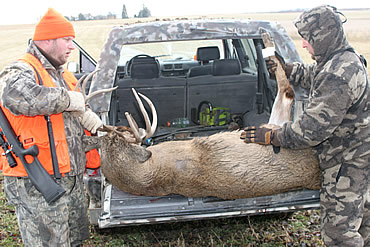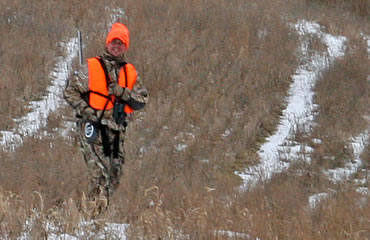You don’t need a crowd to move deer.
What happened to old fashioned deer drives? What was once a long standing tradition in deer camps all over the country is slowly fading into the annals of whitetail history. It could be a result of higher deer populations, or it could be a gradual change in deer hunting culture. Whatever the reason, big, organized man-drives aren’t as popular as they used to be.
Hadley Creek Outfitters camp manager Harrison Lane grew up making drives with large groups, but, like so many others, he’s changed his techniques. Lane spends most of his time in a treestand these days. However, when the deer aren’t moving or Lane is ready for a change of scenery, he’ll grab a friend and orchestrate quick, calculated drives to push deer.
“Two-man drives are a whole lot easier to organize and carry out than drives with eight or 10 guys,” he said.
“You can’t push very large areas, but that’s exactly why they work so well. If you hunt a farm with a bunch of small blocks of trees or some narrow, wooded creek bottoms, two hunters can do a lot of damage to the deer herd if they work together.”
 CREATURES OF HABIT
CREATURES OF HABIT
It helps that spooked deer can be predictable. When danger approaches from a specific direction, they typically flee out the same back door time after time, year in and year out — as long as they aren’t bumped too often. It doesn’t matter if it’s the same buck you’ve been chasing for several seasons or the latest crop of yearlings.
Just as whitetails use the same trails year after year, they will follow the same escape routes when bumped from their beds. It could be a finger of trees leading from a main block of timber, a bottleneck that connects one patch of forest to another or an overgrown fence line that offers a small amount of cover where no other cover exists.
“They’ll do everything they can to avoid running out in the open,” Lane says. “Sooner or later, they’ll have to, but they want to stay in cover as long as they can.”
One of Lane’s favorite spots for two-man drives is a mile-long forested creek bottom that is just 60 to 100 yards wide. It’s not necessarily small, but it has enough key ingredients to make it perfect for a two-man drive: large, open fields along most of its length and at both ends; and thick cover within the trees. The tree line itself is narrow enough that a single shooter can cover the entire width. As Lane says, spooked deer often stay in cover for as long as possible, meaning they’ll slink to the far end of that wooded creek bottom before they bust out across a field. And that means a hunter waiting at the other end can get plenty of action.
Lane admits it can take some experience to determine favored escape routes. He’s hunted some farms for years before figuring out which trails, fence lines and other cover deer used. That’s not to say whitetails won’t surprise you and pull an about-face on occasion — one reason pushing a deer to a single hunter is no guarantee.
Like Lane, Virginia hunter John Clifford also prefers small areas with limited escape avenues. One of his favorite places to push is a 20-acre patch of hardwoods that narrows down to a funnel at the far end where it joins another block of forest on adjoining property. A stander placed in that funnel is almost always guaranteed to at least see deer, but not always.
“Just when you think you’ve got them pegged, they do something completely opposite of what they’ve done every other time you push them,” says Clifford, a 43-year-old computer engineer. “A third or fourth person would be helpful to cover those unexpected escape routes, but I guess that’s just part of it.”
 STANDER’S DUTIES
STANDER’S DUTIES
Whitetails will dart out an unexpected side door if a stander doesn’t use caution as he approaches his designated spot. Clifford hunts a rolling farm in central Virginia where the topography often allows the stander to get into position without being seen. That’s vital. It’s also critical to get into position without being smelled. Any whitetail that sees or smells a hunter will likely figure out something out of the ordinary is happening.
“If I’m the stander, I stay out of sight of the cover my partner is going to push,” Clifford said. “I also approach my stand from downwind. Eventually, you will have to walk up to the tree line, but the less you are visible to any deer that might be bedded in the cover, the better your chances of getting a shot. In some places, I won’t even get close to the area my friend is going to walk through. I get over a hill or in a nearby block of trees where I expect them run to. It’s real important to remain invisible if you are the stander.”
THE SOFT PUSH
Human scent plays a key role in two-man drives, especially for the driver. Instead of plowing through the woods, Lane and Clifford prefer to let the wind carry their scent to bedded whitetails. It’s far less intrusive than actually walking through the cover, but it’s usually enough to get the deer moving. In fact, when whitetails catch a whiff of human, they’ll often ease out the other end, unaware that someone is waiting for them.
“I just walk into a block of timber from the upwind side and stand there for a little while and let my scent blow into the woods,” says Clifford. “Sometimes, I see deer get up and start sneaking away from me. They prefer to escape into the wind, and they will double back on occasion, but if they haven’t been pushed too hard, they will often just walk straight away.”
After a few minutes, Clifford walks perpendicular to the wind so it carries his scent through the entire woodlot. Then he slowly makes his way through the trees, walking through all the known bedding areas as if he were still-hunting. It can take him 30 minutes to cover a 20-acre woodlot.
“You don’t want to go too fast. The less you push deer, the more likely they are to walk out the other end instead of run out,” adds Clifford. “Besides, if they don’t wind me, there’s a chance I can get within rifle distance.”
THE HARD PUSH
Sometimes, simply walking through the woods at a normal pace can be the most effective way to put a deer on the ground. A fast walk can also push deer in a specific direction and prevent them from slipping out a different escape route.
It can also offer opportunities for the walker. Depending on the level of hunting pressure, whitetails sometimes hold tight, expecting the hunter to walk on past.
“There have been many times I’ve been walking through the woods at a steady pace and a deer just stood up right in front of me,” says Lane. “They give you that look like, ‘Where did you come from?’ Sometimes, they’ll stand there long enough to give you a shot.”
He admits that it doesn’t always work, and it almost never works on mature bucks. They’re cautious and smart enough to know it’s best to head for the hills in a hurry. However, it can be a great way to put some does on the ground. The drawback is they’ll be moving fast, and the stander can be caught flat-footed.
Whether you take a shot at a running deer is something only you can decide. If you aren’t sure of your abilities and the background of your target, don’t take a running shot. But stay ready. Spooked deer will often stop and look back, especially if they’ve put enough distance between themselves and the walker. That’s the perfect time to take a shot.
BIG WOODS, TWO HUNTERS
Two people can effectively work big woods that don’t have natural pinch points or obvious escape routes. Clifford does it regularly, but he admits it can be a long shot since deer have the option of running in just about any direction. With a little luck and some forethought, one of those directions could be to you or your buddy.
When Clifford hunts big woods with a friend, the two of them get far enough apart that they can’t see each other. In thicker woods, that could be as little as 200 yards. In open forest, 400 or 500 yards is common. Once separated, they walk either into the wind or quartering into it. The idea is to get whitetails out of their beds and moving toward the other hunter.
“My hunting partner and I know each other well enough that we can stay parallel for a long time, even if we don’t see each other for 30 minutes,” he says. “We move pretty slow, and we kill a lot of deer doing that. They usually run out in front of the other guy and then slow down or even stop. We only shoot at deer out in front of us and never in the general direction of the other guy.”
COMMUNICATION IS KEY
Neither Lane nor Clifford will start even the simplest push without spelling out clear, concise details. Where will you walk? Where exactly will your partner stand? Those details can help eliminate potential safety issues and reduce confusion.
“I learned it’s real important to get your timing right,” notes Lane. “You have to give the stander enough time to get into position so you aren’t running deer out before he’s where he’s supposed to be. I usually wait a bit longer than I think I need to before I make a push.”
He won’t take a shot if he’s not entirely sure where his partner is, even if it means passing up the opportunity for a big buck. No deer is worth the risk. Besides, if you make enough two-man drives, you’ll have plenty of opportunities.
Read Recent Articles:
• Shooting Long Distance: Whitetail hunting isn’t always a short-range game.
• High Mercury Whitetails: Sweat, bugs and extra effort aside, you can take big bucks when the weather is hot.
• Calling All Bucks: What you say and when you say it are crucial to successful calling.
This article was published in the August 2012 edition of Buckmasters Whitetail Magazine. Subscribe today to have Buckmasters delivered to your home.